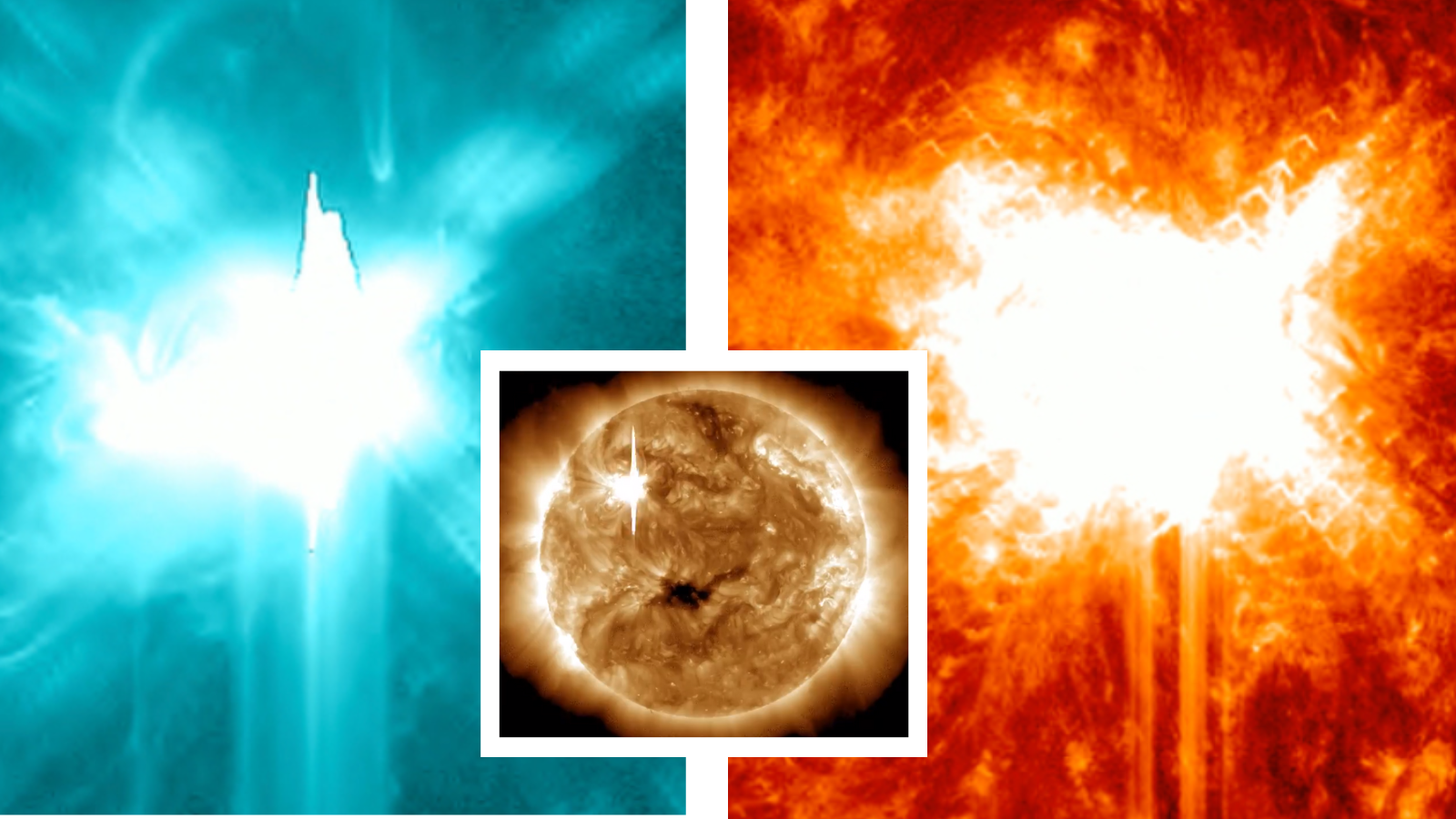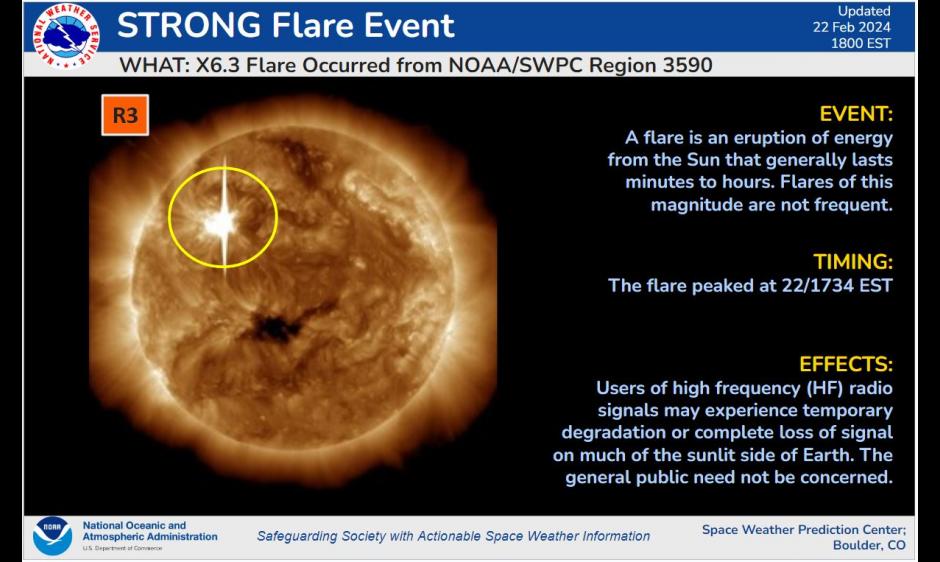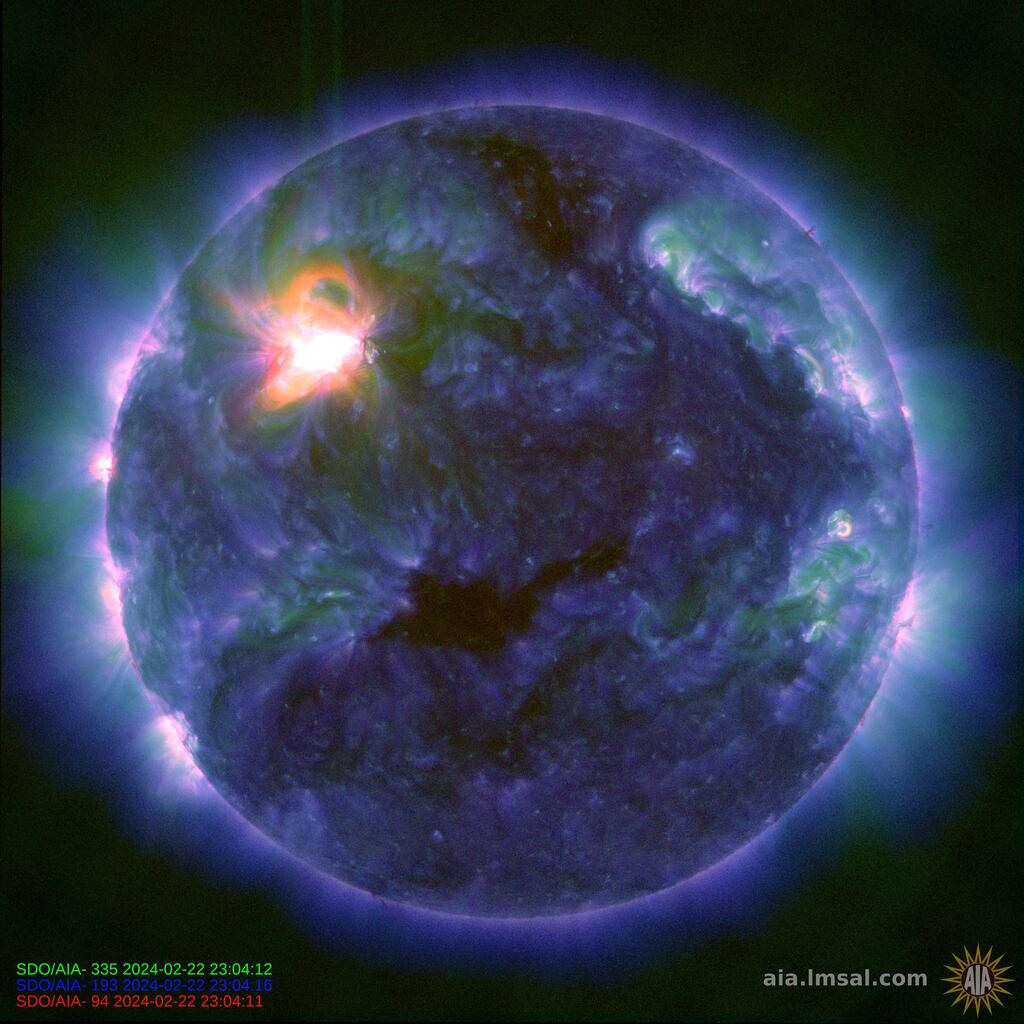Sun erupts with most powerful solar flare since 2017 amid explosive week (video)
The X6.3 solar flare peaked in the afternoon on Thursday (Feb. 22) and was the most powerful of three flares occurring over 24 hours.

The sun has unleashed its most powerful solar flare for around seven years.
The X6.3 class solar flare is the most powerful of the current solar cycle, designated solar cycle 25. The flare reached its peak activity at 5:34 p.m. EST (2234 GMT) on Thursday (Feb. 22), according to the National Oceanic and Atmospheric Administration (NOAA). This was the third solar flare in a 24-hour period from an active solar region on the sun known as AR 3590.
Previously, an X1.8-class flare blasted out of this giant sunspot region at 6:07 p.m. EST (2307 GMT) on Wednesday (Feb. 21), and an X1.7-class flare occurred earlier on Thursday at 1:32 a.m. EST (0632 GMT).
The two previous solar flares from NOAA AR 3590 were not accompanied by massive outflows of plasma called coronal mass ejections (CMEs). According to the European Space Agency (ESA), the X6.3 class solar flare was not accompanied by a CME either.
Related: Powerful twin solar flares erupt from sun as cell phone outages spike across US (video)
Powerful solar flares can affect communications and power infrastructure on Earth when accompanied by CMEs. This can happen when solar plasma strikes Earth's protective magnetic bubble, the magnetosphere. Though the previous two solar flares seemed to be correlated with widespread cellular outages that were reported across the U.S. on Thursday morning, AT&T says the outage was caused by a software issue, according to Reuters.
NOAA said that the X6.3 flare has the potential to cause temporary degradation and loss of signal for high-frequency radio users on the sunlit side of Earth. The agency added that the general public should not be concerned about this X6.3-type flare.
Breaking space news, the latest updates on rocket launches, skywatching events and more!
ESA posted footage of the X6.3 flare erupting from the sun on Thursday afternoon, to its Space Weather feed on X, adding that it would monitor the NOAA AR 3590 region as it rotates toward the center of the solar disk.
❗️Strongest flare of solar cycle 25❗️✨X6.3✨⭕️Peak 22 Feb 22:34 UTC⭕️Origin NOAA AR 3590This AR is making itself known with 3 X-class flares in the last 36 hrs! We'll be keeping an eye on it as rotates towards the centre of the 🌞disk👀🌐https://t.co/qcul5lmV2x pic.twitter.com/EhaMDf3X10February 23, 2024
The European Space Agency (ESA) added that NOAA AR 3590 will soon point directly toward Earth, and further flares are expected from the active region in the coming days. The space agency says that the probability of another strong X-class flare is estimated at 15%, with a probability of more moderate C- and M-class flares over the next 24 hours estimated at 99% and 60%, respectively.
If these flares occur while the active region is pointed directly at Earth and they are accompanied by CMEs, they could cause geomagnetic disturbances when this solar plasma reaches our planet.
ESA adds that the exact impact of the CME will depend on the speed at which the plasma is ejected and whether it directly hits Earth or passes above or below our planet. As NOAA AR 3590 rotates toward Earth over the next 72 hours, this active region will become increasingly magnetically connected with Earth. This means that any energetic solar particles following the magnetic field lines stretching from the sun could impact Earth and satellites in orbit.

The Celestron EclipSmart Solar Telescope 50 is perfect for simple and safe solar viewing. It comes with a backpack, it's portable, lightweight, cost-effective and has built-in white light filters. It has an excellent finderscope too, making it ideal for viewing the upcoming solar eclipse. We've also reviewed the Celestron EclipSmart Solar Telescope and rate it highly.
According to NASA, X-class flares such as this are the strongest class of these eruptions of energy from the sun, they are also quite rare. The weakest class of solar flares is a B-class solar flare, the next strongest a C-class, then M-class, and then X-class flares are the most powerful. Like the Richter scale used to measure the strength of earthquakes, this solar-flare scale increases by a magnitude of 10 with each successive type.
Thus, a C-class flare is 10 times as powerful as a B-class flare, and an X-class flare is at least 1,000 times as powerful as a B-class flare. Within each of these classes, on a sliding scale from 1 to 9, X-class flares have the potential to go beyond X9.
The sun is currently heading toward solar maximum, the point in its 11-year cycle at which it reaches peak activity, which will occur at some point in 2024. This means a ramping up of sunspot frequency, active regions like NOAA AR 3590, and solar outbursts.

Robert Lea is a science journalist in the U.K. whose articles have been published in Physics World, New Scientist, Astronomy Magazine, All About Space, Newsweek and ZME Science. He also writes about science communication for Elsevier and the European Journal of Physics. Rob holds a bachelor of science degree in physics and astronomy from the U.K.’s Open University. Follow him on Twitter @sciencef1rst.


